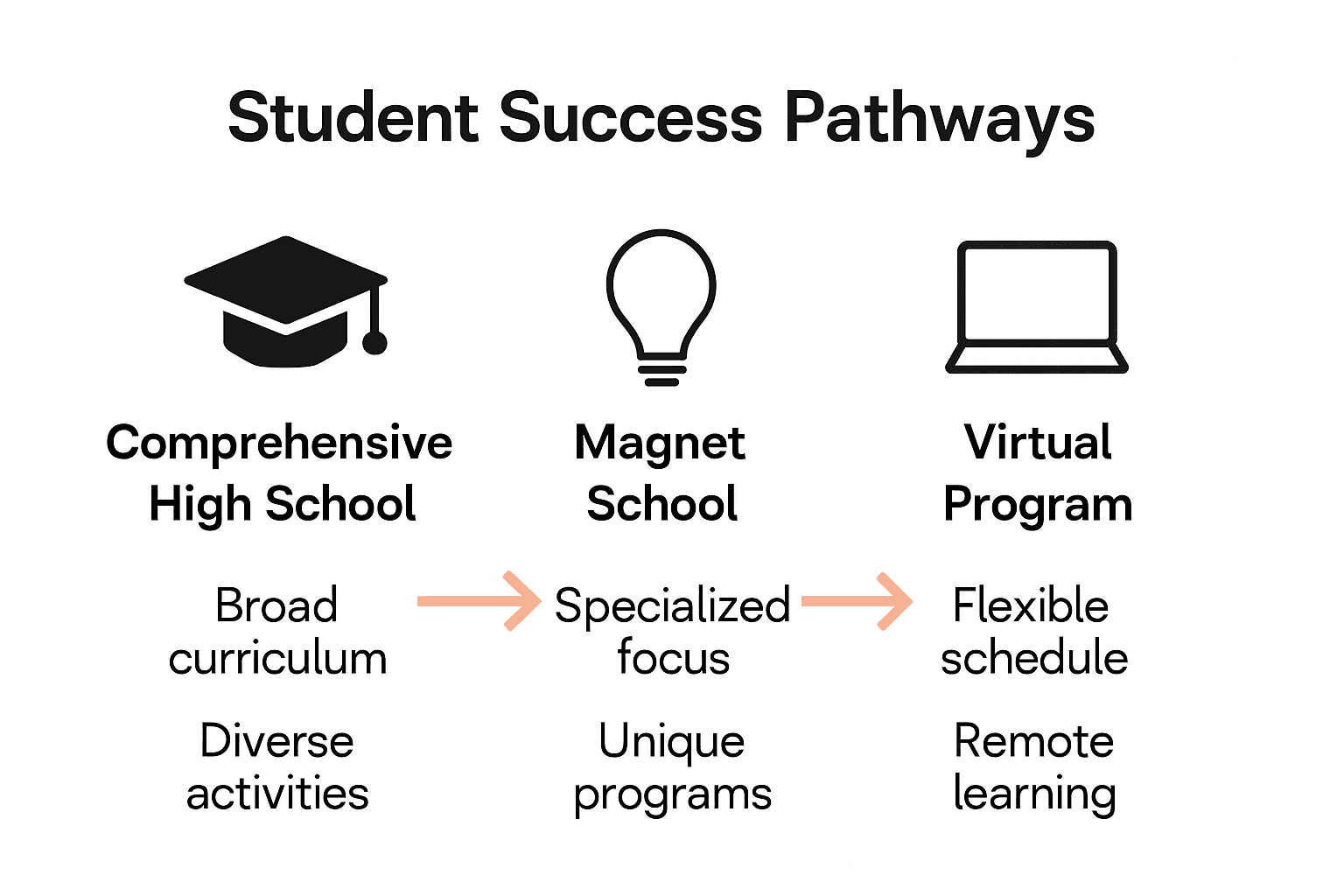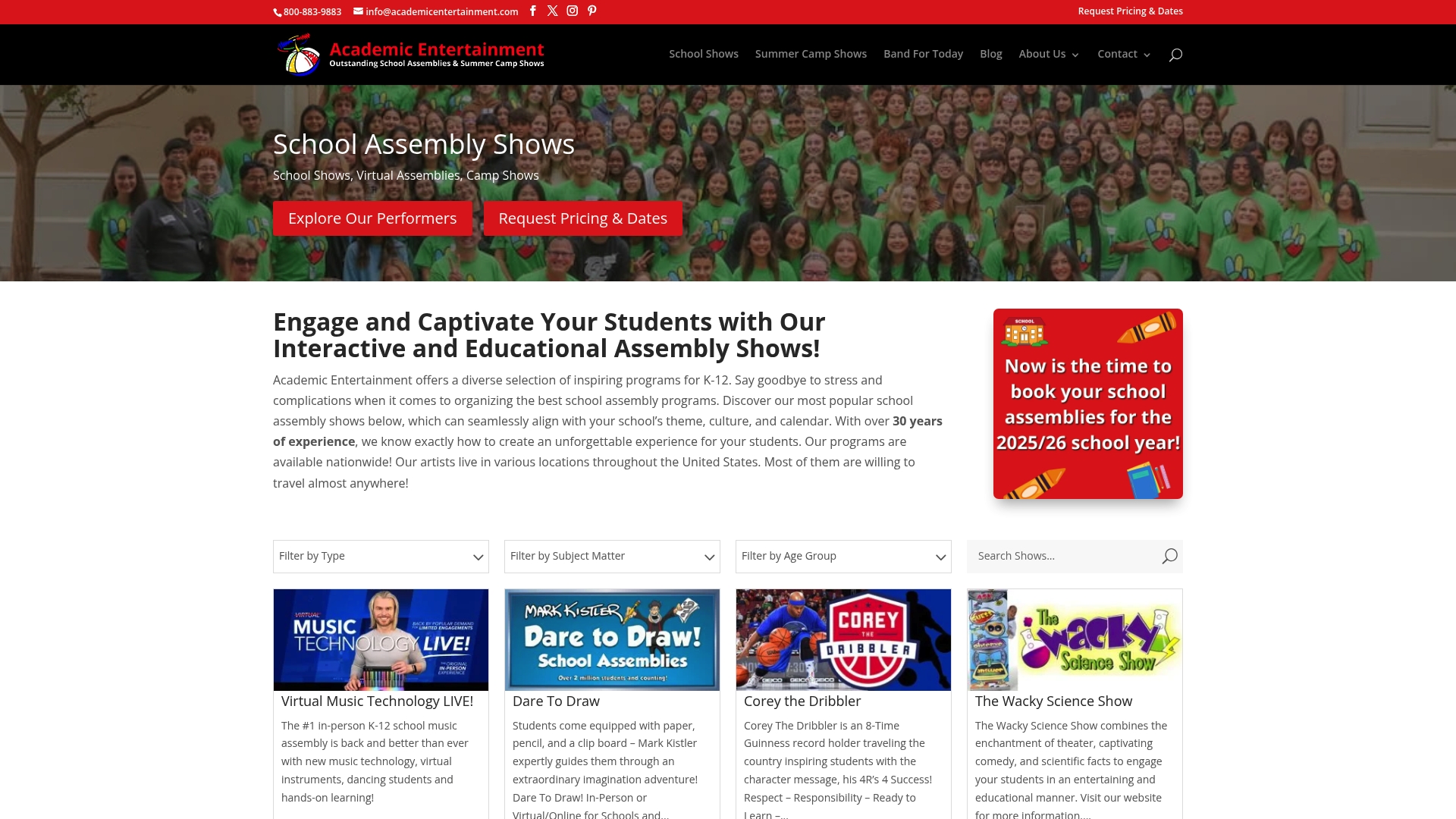Nearly one in four students in the United States attends a school with a specialized curriculum or unique teaching approach. With classrooms becoming more diverse every year, schools are rethinking traditional instruction to help every student thrive. Discover how schools embracing educational variety are creating vibrant environments where all learners can find a path that fits their strengths, interests, and backgrounds.
Key Takeaways
| Point | Details |
|---|---|
| Educational Variety | Embracing diversity in schools fosters inclusive learning environments and accommodates individual student needs. |
| Types of Programs | Comprehensive high schools, magnet schools, and virtual programs create diverse pathways for student success. |
| Enhanced Learning | Varied instructional approaches improve student engagement, retention, and adaptability in learning processes. |
| Implementation Strategies | Schools must focus on curriculum customization and institutional flexibility to support diverse learning experiences. |
Defining Educational Variety in Schools
Educational variety in schools represents a dynamic approach to learning that embraces diversity, recognizes individual student differences, and creates inclusive environments that support multiple learning styles and backgrounds. According to the Council for American Private Education, educational pluralism allows communities and parents to select educational approaches that align with their unique values and student needs.
At its core, educational variety encompasses several critical dimensions:
- Curriculum Diversity: Offering multiple learning pathways and academic programs
- Pedagogical Flexibility: Adapting teaching methods to accommodate different learning styles
- Cultural Representation: Ensuring educational content reflects diverse perspectives and experiences
- Inclusive Programming: Creating opportunities for students from varied backgrounds
As research on equity and inclusion in education highlights, true educational variety goes beyond surface-level differences. It’s about systematically designing learning environments that provide equal access and meaningful opportunities for all students, regardless of their socioeconomic background, learning abilities, or cultural heritage.
By embracing educational variety, schools transform from standardized institutions into dynamic learning ecosystems that recognize and celebrate individual student potential. This approach doesn’t just accommodate differences—it views diversity as a fundamental strength that enriches the entire educational experience.
Major Types of Educational Variety Programs
Educational variety programs represent strategic approaches designed to meet diverse student needs and interests across multiple learning environments. Virtual school programs have expanded these opportunities, allowing students to access specialized educational experiences beyond traditional classroom settings.
According to research on comprehensive high schools, several prominent types of educational variety programs emerge:
- Comprehensive High School Programs: Offering multiple specialization tracks within a single institution
- College preparatory pathways
- Vocational and technical education routes
- Foreign language immersion programs
- Specialized science and technology tracks
- Visual and performing arts concentrations
The federal Magnet Schools Assistance Program further supports educational diversity by funding distinctive school models that promote student choice. These magnet programs typically focus on:
- STEM (Science, Technology, Engineering, Mathematics) curriculum
- Language immersion experiences
- Performing and visual arts academies
- Cultural and global studies programs
- Advanced academic research opportunities
By creating these specialized learning environments, schools can cater to individual student talents, interests, and potential career pathways. The goal is not just academic instruction, but holistic development that recognizes each student’s unique learning profile and aspirational goals.

Here’s a comparison of major types of educational variety programs:

| Program Type | Key Focus Areas | Student Benefits |
|---|---|---|
| Comprehensive High School | College prep Vocational training Arts and languages | Multiple career pathways Skill variety Academic flexibility |
| Magnet School | STEM specialization Arts academies Language immersion | Specialized learning Student choice Inclusive environments |
| Virtual Program | Online courses Independent learning Flexible scheduling | Broader access Custom pacing Technology integration |
How Educational Variety Enhances Student Learning
Learning diversity transforms educational experiences by creating dynamic environments that adapt to individual student needs. Interactive learning experiences play a crucial role in this transformation, enabling students to engage with content through multiple cognitive and sensory channels.
According to research on varied practice, exposing learners to multiple problem-solving approaches significantly improves skill retention and application. Key benefits include:
- Deeper cognitive processing
- Enhanced skill generalization
- Improved knowledge transfer between contexts
- Increased learning flexibility
- Greater long-term knowledge retention
Recent educational research highlights that redesigning traditional learning tasks into collaborative group activities substantially boosts student engagement. By introducing varied learning modalities, students develop:
- Enhanced communication skills
- Stronger peer support networks
- More nuanced understanding of complex concepts
- Increased adaptability in learning strategies
- Greater intrinsic motivation
Ultimately, educational variety isn’t just about presenting different content—it’s about creating holistic learning ecosystems that recognize and nurture each student’s unique potential. By embracing diverse teaching approaches, schools can transform education from a one-size-fits-all model into a personalized, adaptive learning journey that prepares students for an increasingly complex world.
Implementing Educational Variety: Key Strategies
Strategic implementation of educational variety requires a multifaceted approach that goes beyond surface-level changes. Visual learning techniques can play a critical role in diversifying educational experiences and meeting diverse student needs.
According to equity and inclusion frameworks, schools must focus on tailoring programming and resources to reflect student diversity. Key strategic approaches include:
- Curriculum Customization
- Develop flexible learning pathways
- Create modular course structures
- Offer alternative assessment methods
- Design culturally responsive instructional materials
The Council for American Private Education highlights that institutional flexibility is crucial. Strategic implementation involves:
- Institutional Adaptability
- Supporting unique pedagogical approaches
- Allowing diverse accreditation models
- Empowering schools to maintain distinctive missions
- Creating frameworks that celebrate educational differences
Ultimately, implementing educational variety is about creating inclusive environments where every student can express their authentic self. By embracing flexible strategies, schools transform from rigid institutions into dynamic learning ecosystems that recognize, celebrate, and nurture individual student potential across multiple dimensions of learning and personal development.
Common Challenges and Success Factors
Educational variety initiatives face complex challenges that require nuanced, strategic approaches. Benefits of educational entertainment can help schools overcome some of these systemic barriers by creating engaging, inclusive learning experiences.
Research on racial diversity in U.S. schools reveals significant ongoing challenges. According to studies, de facto segregation remains a persistent issue, creating unequal access to varied educational settings. Key challenges include:
- Structural Barriers
- Geographic segregation
- Uneven resource distribution
- Limited school choice for marginalized communities
- Competitive admission processes
- Funding disparities
The Magnet Schools Assistance Program highlights additional complexities in implementing educational variety. Critical success factors emerge from addressing these challenges:
- Strategic Success Factors
- Developing transparent admission processes
- Creating sustainable funding models
- Implementing robust community engagement strategies
- Designing inclusive curriculum frameworks
- Promoting cross-community educational partnerships
Successful educational variety programs recognize that diversity is not just about representation—it’s about creating meaningful, equitable learning environments that empower every student to thrive. By addressing systemic barriers and focusing on holistic, community-centered approaches, schools can transform educational challenges into opportunities for growth and innovation.
Transform Your School’s Educational Variety Into Unforgettable Experiences
Schools everywhere are striving to create inclusive, diverse, and engaging environments, just like discussed in the article. But it is often challenging to move beyond surface-level differences and build practical programs that truly support every student’s learning style and cultural background. If you want to bring curriculum diversity, varied practice, and cultural representation to life, Academic Entertainment can help bridge that gap in a way that sparks genuine excitement and growth.

Discover how you can instantly boost engagement and learning outcomes through interactive learning experiences that align perfectly with your school’s goals around educational variety. Choose from hundreds of customizable live and virtual assemblies covering science, arts, health, diversity, and more. See how visual learning techniques make every topic accessible and meaningful for all students. Visit Academic Entertainment’s main website now to get inspired, customize your perfect program, and start building an education environment where every student’s unique talents are celebrated. This is your chance to make educational variety a daily reality—contact us today for personalized recommendations and booking support.
Frequently Asked Questions
What is educational variety in schools?
Educational variety in schools refers to a dynamic approach that embraces diversity, provides different learning pathways, and adapts teaching methods to accommodate individual student needs and backgrounds.
What are the major types of educational variety programs available?
Major types of educational variety programs include comprehensive high school programs, magnet schools, and virtual programs. Each offers different specialization tracks, such as college preparatory paths, vocational training, and online learning options.
How does educational variety enhance student learning?
Educational variety enhances student learning by creating diverse learning environments that cater to individual learning needs, promoting deeper cognitive processing, and improving student engagement through collaboration and varied instructional approaches.
What are some key strategies for implementing educational variety in schools?
Key strategies for implementing educational variety include curriculum customization, institutional adaptability, and developing inclusive frameworks that celebrate diverse educational approaches while tailoring programming to reflect student diversity.
Recommended
- Virtual Diversity School Shows – Academic Entertainment
- Understanding Benefits of Educational Entertainment for Parents – Academic Entertainment
- Virtual School Programs and Virtual Learning – Academic Entertainment
- Understanding What is Cultural Diversity in Education – Academic Entertainment
- 7 Key Types of Teaching Jobs and Their Benefits Explained – The Education Community Blog



